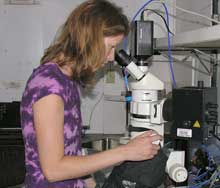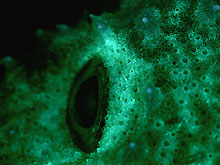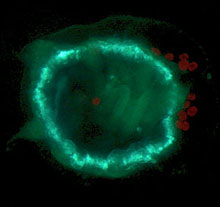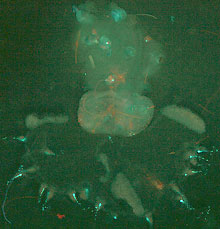
Research Technician Karen Konzen at the microscope specially designed to view fluorescence. Click image for larger view.
Shine On!
August 24, 2005
By Karen Konzen
Research Assistant
University of Florida
Latitude: 29° 09.286' N
Longitude: 88° 00.857' W
As Dr. Mikhail Matz’s Research Assistant on this exploration,
my role is to examine fluorescence in marine organisms – wherever
we can find it, whenever the opportunity arises.
Already, with not even half of the expedition completed, we have found fluorescent
creatures from the surface all the way to depths of 1,800 feet, ranging in size
from plankton to a shark about a meter in length.
![]() Watch video
taken on Aug 22.
Watch video
taken on Aug 22.

Green fluorescing eyebrow of a 5 cm. frogfish collected at 1,800 ft. deep. Click image for larger view.
In order to fluoresce, an organism must be able to produce special proteins that can absorb energy from waves of light that hit them and re-emit it at a different wavelength as fluorescent color. Since there is no light in the deep ocean, why do organisms such as the zooanthid polyps we collected the other day (see Aug 22 daily log) have these proteins? Their fluorescence is incredibly bright when we view them in the right light on board the ship, but how do they use this ability while living at 1,800 feet below the surface?
Since we were not scheduled to dive in the sub today, we took the opportunity to examine organisms collected with researcher Dr. Jon Cohen’s plankton tow net to see if we could find any fluorescence among the myriad of tiny little planktonic critters. We found a lot! We worked until after midnight measuring and photographing several very cool fluorescent copepods, jellyfish and other organisms we will have to wait to identify when we return to shore. Some of the best we found were:

Planktonic copepod, most likely Microsetella sp., with green and yellow fluorescence. Click image for larger view.
- tiny, (and cute) jellyfish with a cyan-colored ring around their bell
and red balls of chlorophyll in their gut (chlorophyll appears
red under the light we use to see the organism’s fluorescence)
- several different species of fluorescent copepods that Dr. Cohen is helping us to identify, including one with most of its body glowing brightly yellow; one with a bright green horn almost as long as its entire body, a green posterior, and a cyan patch on its back and head; a three-eyed copepod (two on top, one underneath) whose body glowed cyan; and a uniquely stick-shaped copepod with yellow and green patches front and back.
- A tiny little medusa-shaped critter with a ring of tentacles, each tentacle glowing with a beautiful bright cyan spot.
A couple days before, we found fluorescent shrimp in clumps of sargassum we caught in a dip net while they floated by the ship. We found hundreds of 5-10 mm. shrimp of at least three different species. One is pictured in Dr. Matz’s Aug 22 log entry. As we saw with the copepods, the cyan, yellow, and/or green fluorescent patterns on these shrimp are highly variable, appearing as spots right behind the eyes, on the joints of the legs, as stripes of dots over their bodies and for some even the eyes themselves glow.
We don’t yet know why we see such variability. Is an animals’ color pattern dependent on species, sex, life stage, different ways of attracting dinner, or…..?? It is also not much good being able to fluoresce if no one can see you doing it. So we are also interested in learning if some organisms can see the fluorescence of those around them.
Man, what an interesting bunch questions to search for answers to. What beautiful and amazing thing to see and discover. This is a really cool job!




























